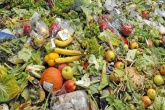Meet the retailer taking grocery chain waste back to the masses
Retailers are an extremely visible facet of the food waste scandal, but there are all sorts of reasons that products fall out of the grocery supply chain. Edward Perchard spoke to Approved Food founder Dan Cluderay to see how he’s turning this would-be waste back into a profit with his online clearance food and drink store
When you think of waste in the grocery supply chain, chances are images of the bins outside supermarkets full of ready meals and bunches of bananas will come to mind, or maybe a pile of carrots sitting on a farm, deemed too big, small, thin or fat for the shelves. But what about the stuff that gets lost in the middle?

According to WRAP, 1.7 million tonnes of food is wasted every year by grocery manufacturers. Around 900,000 tonnes of this, food worth approximately £1.2 billion, is deemed avoidable. And though much (51 per cent) is made up of extremely perishable stuff like meat and dairy, 11 per cent, some 185,000 tonnes of waste, comes from ambient products: the kind of thing you can fill your cupboards with. It’s this waste, created for any number of reasons, that online retailer Approved Food is trying to turn back into edible profit.
Launched in 2008, the website receives 20,000 unique visitors a day and last year shipped 9.8 million items of food, alcohol and household products that have slipped through the supply chain cracks from its Sheffield depot across the UK and Europe. Sourced at manufacturers rather than retailers, Approved Food’s stock is irregular, a new range every week, with 200 different lines arriving at the depot every day in a range of quantities, depending on what’s become available.
The retailer’s founder, Dan Cluderay, says that as online shopping has completely changed the way people buy food, the internet has also opened up avenues for clawing back produce that would otherwise go to landfill, and getting it to the people that it was made for. “There’s been a massive shift in how people buy, what they think is value and what’s socially acceptable. It’s coming into all walks of life, the manufacturer down to the consumer.”
Approved Food pitches its wares squarely at those looking for bargains on groceries, what Cluderay describes as the 'Money Saving Expert group' (he says the average customer last year saved £77 on every order placed). Much of its reputation has come from its sale of items past, sometimes well past, its 'best before' date; products that supermarkets wouldn’t touch with a barge pole. A cursory glance at the company’s website reveals mustard with a best before date in May 2014 and dips labelled July 2015. But Cluderay reckons that around 80 per cent of the company’s stock is in date at any one time. Rather than just being an outlet for food far from its salad days, Approved Food makes itself available for all forms of perfectly edible ‘waste’ created by the grocery supply chain.

“We get stuff for loads of different reasons: new product launches, end of competitions, stock control mistakes, over-production... right now we’re buying up lots of Christmas chocolate eggs. They’re in date until July, but are seasonally out of date. In a world where you’re paying for storage, pallets and so on, someone’s decided that they’re not going to be in date for next Christmas, so they’ve just got to do something with them.” We’re used to seeing shops flooded with Christmas, Easter and Halloween-themed goods, but what happens to the unsold stuff when the decorations have been taken down? It’s not just food: when we spoke Cluderay had just taken an order of toilet paper with a Christmas tree motif – it does the job all the same.
The biggest reason for products winding up on Cluderay’s shelves however is stock management. Shopkeepers, like shoppers, will look for stock that has the longest date on it to maximise its time on the shelves, meaning that pockets of stock will go unsold. Manufacturers don’t want to set a precedent with regular retailer customers by selling aging goods at a cheaper price, so Approved Food fits into a handy pocket.
“I think one of the things manufacturers are most concerned about is looking after their brand and they don’t want their brand to be sold cheaper – if it's worth £1.99 they don't want to see it at £1.00 unless they're in control of that. And that's where we've actually fitted in quite well because I think we're seen in the industry as a bit of an odd ball because we sell short-dated and out-of-date food, and actually that works quite well because the manufacturers see us as a place to put things, I suppose the TK Maxx of food and drink.”
Brand fears that a marked-down product will look cheap next to a competing brand, Cluderay suggests, would in the past have been a large cause of food products going to landfill, with manufacturers preferring to maintain a brand’s reputation than to protect its wares themselves. But he thinks that is changing, with WRAP’s Courtauld Commitment 2025 and a shifting public awareness of food waste meaning that wanton disposal of products stands to do just as much harm to reputations.

“When I look back to when I first started in 2001, there was a lot more waste then,” Cluderay recalls. “Over the last 15 years there has definitely been an improvement and I think this is a lot to do with computer systems, better forecasting tools but I think there will always be waste, and the pursuit of no waste in my opinion will cost an absolute fortune. I think the answer is a better transparency and food banks, companies like Approved Food, those types of relationships, that are a good fit.”
Indeed, there are now a range of organisations that provide an outlet for this evolving approach to waste. And while food redistribution charities, like Fareshare, cover smaller quantities of surplus food, companies like Cluderay’s are going after larger stocks and more niche products. “We’re one funnel of the great big food waste debate. Food banks are after the key things, your staples like bread, milk, cheese, meat; they don’t want things like blancmange. I’ve just got 26 pallets of it. And they don’t want to be giving out food past its sell-by date.”
While food banks have been around for a long time, and will unfortunately be needed in even greater numbers in years to come, the internet has facilitated the growth of organisations taking surplus goods off the hands of manufacturers and retailers and putting it in the grasp of human consumers, as Cluderay explains: “Food sharing apps are very much about the front line in stores like Tesco and Sainsbury’s. There’s good work there about food that really is going to go in the bin. Where we sit is further up that supply chain, with the forklift trucks. They just don’t want the things in that sort of quantity further up the supply chain, which is where we’re pitched.”
He points to the example of crisps, where over-production is deemed necessary to ensure that an issue in the manufacturing process doesn’t scupper a whole order. “The most expensive thing in a bag of crisps is the actual bag, so if you are committed to making a million bags of crisps you make enough foil bags for 1.1 million, just in case. Once you’ve made those one million bags for that order, what do you do with the foil? The best thing to do is to put some crisps in it and sell it as a product and get some money back.”
Rather than a last resort, Cluderay wants his company to be seen by manufacturers as part of the process, providing industrial symbiosis to companies looking for an outlet for their waste. “We want to be a part of their waste stream,” he says. “We pay decent money for a lot of these things, so the manufacturers will want to deal with us again because we fit with what they’re looking for and we can move it onto our customers: mainly families in the UK, because we don’t do trade customers.”
Because of the route it takes to get to Approved Food, much of the products on its shelves are ‘short-lived’, with many past their ‘sell by’ or ‘best before’ date. This means that a packet of crisps may have lost a bit of their crunch, but nothing much more than that. Many shoppers may turn their nose up at these products, thinking them unsafe or spoiled, but Cluderay says this lack of education about what the various labels mean is playing a big role in the amount of food being wasted in the UK. “Labelling has come on leaps and bounds for all sorts of different reasons in the last 15 years, but there’s a piece still to be done on it. Right now there’s ‘use by’ dates and ‘best before’ dates, there’s ‘sell by’ dates, ‘display until’ dates and whatever other date you make up as you go along. I think we need to chop them down to two dates and then educate people that ‘use by’ is about health and safety, it’s microbiologists’ evidence and science that says this will make you ill, whereas ‘best before’ dates are a guide to the optimum quality.”
 This article was taken from Issue 88
This article was taken from Issue 88A WRAP report published in February said that ‘good progress’ has been made on products with multiple dates printed on the label, with instances falling from almost 40 per cent in 2009 to less than three per cent in 2015, but concluded that more needs to be done to inform consumers on how to store products to maximise their lives, with potential benefits of £1 billion to businesses through labelling changes. And just before Parliament broke up before its latest pre-election break, MPs on the Environment, Food and Rural Affairs Committee reported on the need for more public awareness work on food waste, particularly in incorporating lessons on how to avoid needless waste into the curriculum. This is something that Cluderay is in full agreement with, pointing out that evolutions in labelling have not been accompanied by education, leading to a “generation gap” in knowledge.
“All the grans and granddads who had a much more thrifty approach – whatever they cooked on Sunday would be used on Monday and Tuesday in a sandwich or stew – didn’t care about best before dates. When best before dates came in no one ever educated my generation about what these dates were, and now there’s a whole load of people relying on them. It’s just that they’re misinformed, they’ll pull out a tin of beans out of the cupboard because it went out of date last week. If you’re treating a can of beans the same as you are chicken there’s a piece missing in the middle of education.”
Cluderay adds: “Best before dates do have a place, they are really there for the people in store to make sure they’re managing their stock, but it is an arbitrary date that’s put on so that retailers and consumers know how old something is. It’s definitely needed, but it’s just a cleaning up of what all these dates mean, I think that would be a great place to start.”









